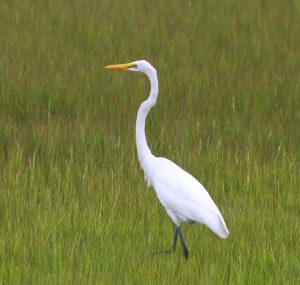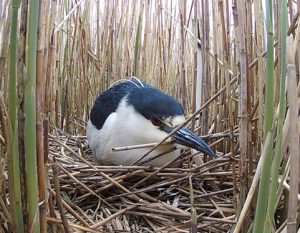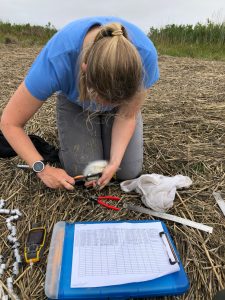by Sam Collins, Research Scientist
Spend any time around a marsh and you’ll come across a familiar sight: Elegant, long-legged birds wandering among the grasses or hunting in the shallow water. These birds – herons and egrets – are some of the wetlands’ most iconic species. They belong to a group known as wading birds, which includes cranes, egrets, herons, storks, spoonbills, and ibises. Wading birds have physical and behavioral adaptions for living in wetland ecosystems, like extra-long legs to help keep feathers dry when wading through the water, toes that are thin and splayed to disperse their weight and prevent them from sinking in the mud, and bills designed for spearing fish or probing the mud for insects.
Most wading birds nest in colonies, a strategy that gives each individual a better chance of escaping an intruding predator while tending to its nest. These nesting colonies are usually made up of different species of wading birds and are often shared with other water-associated birds, like gulls and cormorants, as suitable nesting sites are increasingly in short supply. To help ensure reproductive success, these birds typically select nest sites in areas secluded from the mainland and its host of mammalian predators, within elevated areas to reduce the likelihood of nest flooding, and among vegetation that conceals incubating adults and young.
New Jersey’s wading birds have experienced shifts in nesting abundance and distribution state-wide, and many are now considered species of concern. Habitat loss associated with coastal development and increases in flooding within nesting areas are major concerns for these species. Sturgeon and Gull Islands, located just north of The Wetlands Institute and part of the Seven Mile Island Innovation Lab, are crucial nesting areas hosting an estimated 25 percent or more of all nesting wading birds in the state – including Great Egret, Snowy Egret, Glossy Ibis, Black-crowned Night Heron, Tricolored Heron, and Little Blue Heron. Scientists at the Institute are studying the nesting habits and success of wading birds at these sites to understand nesting habitat preferences, causes and timing of nest loss, and changes in species abundance and distribution within and between seasons. What we learn should lead to better nesting area management and the development of habitat enhancement plans.
Studying these birds is no easy task. We limit our time in the colonies to reduce disturbance, and dense vegetation limits the visibility of our subjects. To help address these challenges and to better assist in understanding survival and return rates, this year we began banding Great Egret adults and chicks. Great Egrets captured on Sturgeon or Gull Island wear bright yellow bands with black codes that are readable from a distance. We have already resighted some of the banded fledgling chicks feeding in the marshes around the Institute – and you can help as well. If you see a banded Great Egret, note the color and code on the band, the date/time, and location – and grab a photo if you can. We appreciate any direct reports of our banded birds (scollins@wetlandsinstitute.org), or you can report to reportband.gov.
Research on these wading birds has been used to inform restoration projects using material dredged from navigation channels to create habitat that will benefit colonial nesting wading birds and other marsh-dependent species. You can help with these and other efforts that work toward enhancing populations of sensitive coastal bird species by participating in our adoption program. By symbolically adopting an Oystercatcher, you directly help fund critical research and conservation activities through our Coastal Birds Program at The Wetlands Institute. Stay tuned and look for more opportunities to contribute to these efforts!



